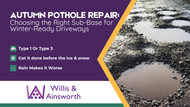Autumn brings two certainties to Berkshire, Hampshire, and Oxfordshire: falling leaves and deteriorating driveways. After months of summer traffic and now facing increasingly heavy rainfall, those small potholes and rutted areas are about to get much worse. The good news? Now is the perfect time to repair them before winter's freeze-thaw cycles turn minor issues into major problems.
The question most people ask: should I use Type 1 or Type 3 sub-base? The answer depends on what you're trying to achieve. Let's break it down simply.
Understanding the Difference
Both Type 1 and Type 3 are 0-40mm crushed limestone or granite meeting Ministry of Transport specifications. The key difference? Fines content.
Type 1 MOT - The Load-Bearer
What it is: 0-40mm aggregate with controlled fines content
Best for: Maximum load-bearing capacity and stability
Perfect for:
- Repairing potholes in existing driveways
- Building new standard driveways and paths
- Car parks and heavy traffic areas
- Creating solid, stable bases
Type 3 MOT - The Water Manager
What it is: 0-40mm aggregate with reduced fines content
Best for: Superior drainage and SUDS compliance
Perfect for:
- Permeable paving systems (required for many new driveways)
- Areas with drainage problems or waterlogging
- Farm tracks and fields needing better water management
- Tennis courts, sports pitches, and equestrian arenas
Why Autumn Repairs Matter
Potholes don't improve with age—they accelerate. Here's what happens as we move through autumn and into winter:
Stage 1 (Now - November): Surface water penetrates small cracks and worn areas. The sub-base beneath starts to soften and become unstable.
Stage 2 (December - January): Freeze-thaw cycles begin. Water trapped in the sub-base freezes, expands, and breaks up the material further. Small potholes become large craters.
Stage 3 (February onwards): Major damage requiring complete reconstruction rather than simple repairs. What could have been fixed with a few bags of aggregate now needs machinery and significant expense.
Choosing Your Material
Use Type 1 When:
- Repairing existing potholes: Type 1's controlled fines provide maximum compaction and stability
- Your driveway drains reasonably well: No regular puddles or waterlogging issues
- You want maximum strength: Heavy vehicles or high traffic areas
- Budget is a priority: Type 1 is the standard, cost-effective option
Use Type 3 When:
- Water sits on your driveway: Regular puddles indicate drainage problems that Type 3 can help solve
- You're building a new driveway: Check planning requirements—Type 3 may be required for SUDS compliance
- Working on farm tracks or fields: Type 3 allows ground to breathe and processes rainfall efficiently
- Clay soil causes problems: Type 3's drainage properties prevent waterlogging in clay-heavy Thames Valley soils
Quick Repair Guide
For Small Potholes (Under 1m²):
1-2 tonnes of Type 1 typically handles 3-4 small pothole repairs at 100-150mm depth. Clean out loose material, compact the bottom, add Type 1 in layers, and compact thoroughly.
For Rutted Track Repairs:
Type 3 works brilliantly for farm track ruts and gateway repairs. The improved drainage prevents ruts reforming while maintaining trafficability even in wet conditions.
For Complete Driveway Refresh:
Calculate your area in square metres, multiply by 0.15 (for 150mm depth), then by 2-2.2 to get tonnes needed. A typical two-car driveway needs 10-15 tonnes depending on condition.
Need Help Calculating Quantities?
Use our online material calculator or call our experienced team for advice on the right material and quantity for your specific project.
Delivery available from 1 tonne • Bulk bags or loose loads • Trade discounts available
? Call: 01635 862664
Common Questions
When should I repair my driveway?
November or December is the ideal time to repair your driveway before winter ice arrives. Fixing potholes now prevents freeze-thaw damage that turns small problems into major repairs by spring. The ground is still firm enough for access, and you'll avoid navigating dangerous potholes through winter months.
What causes driveway potholes?
Water penetrates cracks and softens the sub-base beneath. When temperatures drop, this water freezes and expands, breaking up the material. Repeated freeze-thaw cycles through winter progressively enlarge small cracks into potholes. This is why autumn repairs are so important—fix them before the ice arrives.
How much do I need for pothole repairs?
As a rough guide: 1 tonne covers approximately 6-7 square metres at 100mm depth. For typical driveway potholes, start with 1-2 tonnes and you'll likely have enough for several repairs.
Can I do this myself?
Absolutely. Pothole repairs are straightforward DIY jobs requiring just a shovel, rake, and plate compactor (can be hired). Remove loose material, compact the bottom, add aggregate in 100mm layers, compact each layer thoroughly. Done.
Will it work in wet weather?
Type 1 should ideally be laid in dry conditions for best compaction. Type 3 handles wet weather much better thanks to its drainage properties. Avoid both in heavy rain or on waterlogged surfaces.
Delivery Throughout Thames Valley
We deliver both Type 1 and Type 3 sub-base throughout Berkshire, North Hampshire, and Southern Oxfordshire:
Minimum delivery: 1 tonne (1000kg)
Available as: Loose tipped or bulk bags (10 bag minimum)
Load sizes: 11 tonne, 20 tonne, or 28 tonne artic loads for larger projects
Service areas: Thatcham, Newbury, Reading, and all surrounding areas
Take Action This Autumn
Don't wait for those small potholes to become major problems. November offers ideal conditions for repairs—ground is still firm, weather is manageable, and you'll beat the winter rush. Whether you need Type 1 for pothole repairs or Type 3 for drainage solutions, we have the right material in stock and ready for delivery.
Order online or call us on 01635 862664 for expert advice.


